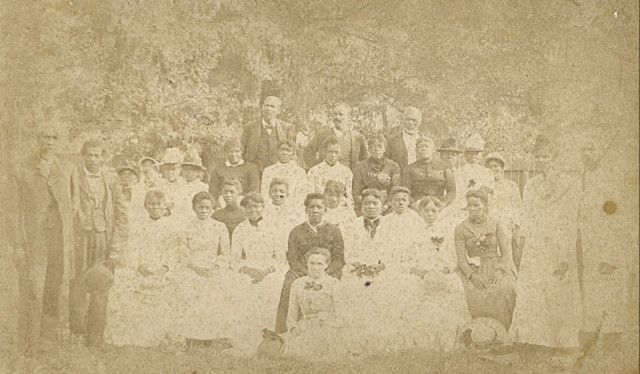Many of the photographs that survive from these early decades of the celebration — including sets from Houston and Corpus Christi — depict elegantly dressed groups in horse-drawn carriages elaborately decorated with flowers down to the wheels. Another set from Austin — taken in 1900 by Grace Murray Stephenson — shows a group of older people, many or all of whom would have been born into slavery, dressed up for the day, as well as a very well-posed six-piece band, and a group of men decked out in Civil War uniforms (perhaps reenacting the Union’s entry into Galveston).
Of course, violence toward Black Americans did not magically evaporate with emancipation, and racial segregation and prejudice in some places made Juneteenth celebrations very difficult. Often forbidden from celebrating on public land, many gatherings had to be disparately held in remote rural areas or small church grounds, leading some Black Texan communities to band together and buy land specifically for celebrating Juneteenth (and other community occasions). The first such communally-bought land was Houston's Emancipation Park, a ten-acre lot purchased in 1872 by the Colored People’s Festival and Emancipation Park Association led by the Baptist minister and formerly enslaved Jack Yates. You can see Reverend Yates pictured (far left) in the Juneteenth group shot below (and in the featured image above, two of his daughters in a decorated carriage).

Group on Emancipation Day, circa 1880s, in Houston's Emancipation Park. Reverend Jack Yates, who led the community purchase of the Park in 1872, is pictured on the far left, and his daughter Sallie Yates dressed in black in the centre — Source
Following Houston's example, in 1898, Mexia's Nineteenth of June Organization bought an area of land on the banks of the Navasota River, now known as Booker T. Washington Park, which was said to draw up to 30,000 for the celebration. Another dedicated community-bought land was in Austin. The photographs we've featured of the city's Juneteenth celebrations of 1900 took place in what was then called Wheeler's Grove (now Eastwoods Park) but a few years later an association, led by the formerly enslaved Thomas J. White, purchased a plot for the purpose, also named Emancipation Park (although 30 years later the city of Austin seized it to build housing).
Over the course of the late nineteenth and early twentieth centuries, Juneteenth festivities became increasingly common outside of Texas — often brought to new places throughout the country by Black Americans who’d moved away from the state. In the 1950s, the holiday temporarily faded in popularity. This was to some extent due to the Great Migration, when many Black Americans found themselves in northern cities, working for bosses who did not recognize Juneteenth. (The US Congress has still not recognized it as a national holiday, although forty-seven states do at least acknowledge its existence.) It was also to some extent due to the changing political attitudes of the mid–twentieth century, when celebration of difference was sometimes seen as antithetical to integration.